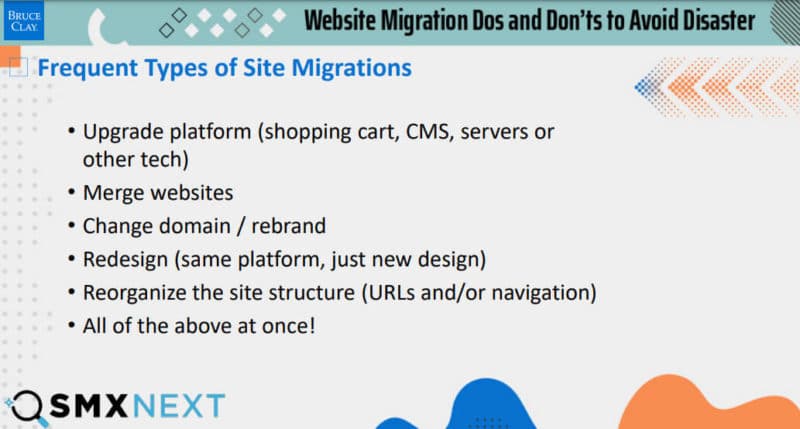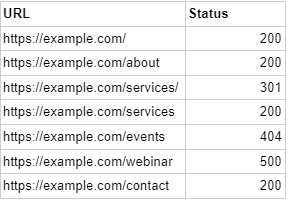“Migration is a burden that we all have with websites,” said SEO industry leader Bruce Clay at SMX Next. “We have to upgrade them periodically. A stale or an out-of-date website deteriorates your rankings in the search engines.”
“There are all sorts of reasons to do it — maybe you have an e-commerce platform or just need an upgrade,” he added.

Design upgrades, domain changes for a rebrand or necessary website merges can all necessitate a website migration. But, with so many moving pieces, the potential for errors — both from a ranking perspective and a site functionality standpoint — can increase if site owners and SEOs aren’t prepared.
Here are some of the most important do’s and don’ts Clay recommends SEOs consider when migrating a website.
What to do when migrating a website
There are many tasks involved when migrating a site, but the following are critical for preserving your rankings.
Make an inventory of old URLs. Before beginning the migration process, marketers and site owners should put together a list of all their current URLs. This will establish a baseline to use as a comparison with the new site. Clay pointed out that running this inventory will inevitably uncover URL errors such as 400/500 status codes or redirect chains, so marketers should make note of these before the migration. SEOs can pull this data using one of many free crawling tools.

Benchmark old rankings. Migrating a website will almost always result in ranking changes, and if you don’t know the original rankings, it can be difficult to figure out what caused those changes in the first place. That’s why Clay recommends noting the old site’s rankings: “You’re going to want to benchmark your rankings and any performance metrics you might have. You’re going to want to run analytics reports and ask yourself, ‘What rankings do I have right now? How is it [the site] performing and how am I going to be able to move forward?'”
Create a backup of the old site. Site owners should regularly back up their sites, but this is even more crucial during the migration process. If something goes wrong with the new site, you’re going to need the old version to fall back on. Marketers should consult a developer to make sure this is done correctly.
Plan the navigation and structure of the new site. Site structure is critical to the SEO success of any domain. And while it’s ultimately up to you what format is chosen, Clay recommends implementing a siloed structure with a hierarchy of pages on the new site to ensure its content is ranked most effectively.
When you’re ready to migrate your content to the new site, be sure to address the errors identified during the inventory process and make sure everything is ready to be transferred.
Get the daily newsletter search marketers rely on. See terms.
What not to do when migrating a website
SEOs can sometimes get so caught up in the high volume of migration tasks that they fail to set the new site up for success. Here are some big “no-nos” when it comes to transferring the old site to the new version.
Don’t delete your old site. Many site owners might be tempted to delete the old site once the new site is up and running, but Clay recommends keeping it live to ensure all the content and signals are transferred: “You could put the old site on the hard drive and just rename the directory. There are lots of things you could do, but make sure you have your old site and don’t take it down if you don’t have to.”
He also said that some webmasters end up copying their old site onto the new site, only to have the new site fail. Having the old site live — ensuring it redirects to the new version — is critical in these early stages in case something goes wrong.
Don’t use the staging site’s robots.txt file. Before using the new site live, don’t use the staging site’s robots.txt file, which could keep search engines from indexing your site. It’s always best to have a new version ready to be uploaded before the new site goes live.
“Don’t copy that robots.txt into production or you’re going to be blocking your new one,” said Clay.
Don’t schedule the migration when your traffic levels are highest. Site owners should avoid pushing a migration while experiencing high levels of traffic. This can disrupt your users’ experience and, ultimately, result in huge traffic losses.
“Wait until your traffic levels are a little bit calmer,” Clay said. “Sometimes this is harder. Maybe you have a site that’s active 24/7, international or in season. But if you’re going to migrate and there’s an off period, that’s the right time to do it.”
Don’t panic if/when rankings drop. There’s almost always going to be a shift in rankings after a site migration, and that’s okay. Unless there’s a major error — such as a redirect problem from the old site — these fluctuations should be temporary. Google and other search engines need time to recrawl your site and take note of the changes.
“There’s going to be re-spidering happening. It’s going to take some time for Google to figure out what your site is. You know you’re going to take a hit in many cases now. We have had cases where we have done everything right, migrated it and don’t see traffic loss.”
“That’s wonderful, but don’t count on it. And whatever you do, don’t panic,” he added.
Site migrations are complex by design, but they don’t have to be disastrous for your SEO. With the right planning, marketers and site owners can enjoy the benefits of a brand new site after the move.
Watch the full SMX Next presentation here (free registration required).
The post SEO dos and don’ts of website migration appeared first on Search Engine Land.
No comments:
Post a Comment